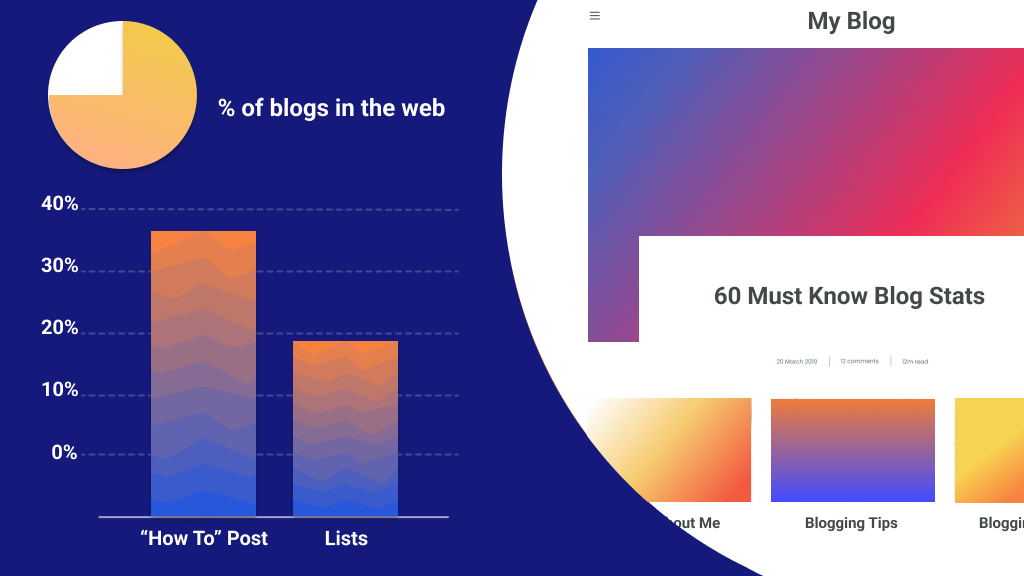Blogging has been around for over two decades now and has undergone many changes in that time. But with the advent of social media, video content, and other digital marketing channels, there's a growing sentiment that blogging is no longer as relevant as it once was. But is this really the case? Let's take a closer look at the latest blogging stats to see what they tell us about the rise and fall of this age-old marketing channel.
Start Here!
Is Blogging Dead or Simply Evolving?
Blogging is one of the most widely used digital marketing channels of all time. It has become a massive industry, with millions of bloggers creating content and driving traffic to their sites every day.
But despite its popularity, many are saying that blogging is no longer as relevant as it once was. With social media channels like Instagram, Twitter, and Facebook, people are able to share their thoughts and opinions in real-time, without having to create a blog post. And with the rise of video content and podcasting, and the popularity of Tik Tok, many are questioning whether blogging is still worth their time and effort. So what do the latest blogging statistics tell us about the future of this marketing channel?
1. Blogging popularity statistics
_webp.webp?71122.69999980927)
Blogging has been one of the most popular forms of online content for over two decades, and the numbers continue to grow every year. With the rise of the internet and the increasing number of people who use it, the popularity of blogging has skyrocketed, making it one of the most widely used digital marketing channels of all time. But just how popular is blogging now? Do people still view it as a successful strategy to build website traffic and drive users to their content?
- In 2022, videos, blogs, and images were the most popular types of content created by marketing teams.
- With over 600 million blogs in the world, out of a total of 1.9 billion websites, authors are producing over 6 million blog posts daily, which amounts to over 2.5 billion annually.
- 70% of people prefer to receive information from blogs rather than traditional advertisements.
- 68.52% of respondents believe that blogs give credibility to a website.
Marketers and businesses can't get enough of blogging, and neither can your audience. With a staggering number of people preferring to get their information from blogs instead of boring old ads, it's clear that blogging is the way to go.
Just take a look at the sheer number of active blogs and blog posts being produced every day! That's proof positive that blogging is still the backbone of a winning digital marketing strategy.
2. B2B blogging statistics
_webp.webp?95837)
In today's digital age, blogging is a critical component for businesses looking to reach and engage with their target audience. With the number of active B2B blogs and blog posts on the rise, there's never been a better time to explore the world of B2B blogging.
- B2B companies receive 2X more revenue from organic search than from any other channel.
- Combined search traffic in the B2B sector makes up 76% of all trackable traffic.
- 71% of B2B buyers have reported consuming blog content during the purchasing process.
- 47% of B2B customers view three to five blog posts before contacting a salesperson.
- 50% of B2B e-commerce companies consider blogging as their primary marketing strategy.
- Bloggers were spending an average of 4 hours and 10 minutes writing a single article in 2022.
- B2B bloggers are part of 4% of bloggers who write long-form articles with a length of 3000 words or more.
- B2B bloggers spend 26% more time on each article compared to B2C bloggers.
- The typical B2B article is 1460 words, while B2C articles are 1300 words, resulting in B2B bloggers writing articles that are 12% longer on average.
Blogging is a game-changer for B2B companies. With organic search driving high revenue, a significant portion of B2B search traffic, and long-form articles building credibility and authority, it's no wonder so many B2B e-commerce companies choose it as their go-to marketing strategy. B2B bloggers put in the time to craft compelling content and in return mind-blowing results.
3. Blogging results statistics
_webp.webp?153791.29999923706)
Blogging is a powerful tool in the world of marketing and business, but how exactly does it drive revenue? From organic search to the influence on the purchasing process - let’s discover what’s making blogging a revenue-generating machine.
- A large majority of bloggers, 80%, report positive results from their blogging efforts.
- According to marketers, 60% see inbound strategies such as SEO and blog content as their top source for quality leads.
- Companies with business blogs experience lead growth of 165%, compared to companies without blogs who only see a 73% lead growth.
- Business blogs have been proven to generate 67% more leads per month.
- Monthly leads for businesses with blogs rise 126% more than those without.
- Over half of marketers who use blogging as a tactic find it to be effective, and 10% report it to have the highest ROI.
- Marketers who prioritize their marketing efforts, including making blogging a priority, have a 13 times greater chance of seeing a positive ROI.
- Marketers often use traffic as a metric to measure the success of their marketing strategies, ranking as the second highest metric.
- The four highest blog traffic niches are food, lifestyle, travel, and arts&crafts.
- The food blog niche is the most profitable, with a monthly average of $9169 in 2022.
Blogging is a marketing powerhouse that drives results for businesses of all sizes. The majority of marketers recognize it as their top source of leads and the best way to achieve the biggest ROI. Especially lucrative are niches like food, lifestyle, travel, and arts&crafts. But there is still room for new, engaging content and making the first move as a blogger whose results soar year around.
4. Blogging content statistics
_webp.webp?182424.5999994278)
If the ideal length of article or type of content exists? No… or maybe. Let’s dive into what makes blog content so effective and learn all tips that will make every content hard to pass by.
- The quality of content is considered the number one factor for blogging success.
- 41% of bloggers create content based on original research.
- Bloggers who conduct and publish original research are 41% more likely to see better results.
- What kinds of content are bloggers publishing?
- How-to articles (76%)
- Lists (55%)
- Guides & eBooks (long form) (43%)
- News and trends (43%)
- Opinion (38%)
- Interviews (34%)
- Gated content (27%)
- Webinars (25%)
- Infographics (24%)
- Roundups (22%)
- Guides & eBooks (35%)
- Gated content (35 %)
- Infographics (33%)
- Roundups (32%)
- Interviews (30%)
- Long-form content tends to receive 77.2% more links than shorter articles.
- The average length of a blog post in 2022 was 1376 words.
- 66% of bloggers publish content weekly, monthly, or in between. Bloggers who publish 2-6 times per week are 50% more likely to see positive results.
11 Mistakes Of Amateur Bloggers You MUST Avoid!
- Finding time to create and promote content (52%)
- Getting traffic and attracting visitors (46%)
- Creating quality content consistently (39%)
- Creating enough content consistently (33%)
- Updating old posts is 2.8 times more likely to result in strong outcomes.
- Most bloggers include 1-3 images in a typical post, but a small percentage create highly visual articles with 10 or more images. Bloggers who use 7 or more images are 2.3 times more likely to see strong results.
- Posts with an image every 75-100 words tend to get 2 times more shares than those without.
- One in four bloggers add video to their articles.
You can try out the most creative way to improve your content, but still quality is the number 1 for every recipient. With adding to it consistent publishing, revitalizing old posts, adding eye-catching visuals, and incorporating video you make sure that every content that you create is addictive leaving users come back for more.
5. Blogging promotion statistics
_webp.webp?210427.39999961853)
Creating even the most engaging post in the world won't do anything if potential viewers don't know it exists. However, what is the best way to promote a blog that will provide a gigantic flow of traffic? Let's find out.
- Over the past two years, over 50% of bloggers have found it more challenging to drive traffic from Facebook and almost one-fifth from Google.
- Higher-income bloggers place a lower significance on social media compared to lower-income bloggers.
- Long-form content tends to receive more social shares, but there is a diminishing return for articles that exceed 2,000 words.
- Only 1.3% of articles generate 75% of all social shares, making these articles "Power Posts".
- Headlines that are 14-17 words long generate 76.7% more social shares than shorter headlines.
- The formats of "Why Posts", "What Posts", and infographics are ideal for link building and receive an average of 25.8% more referring domain links than how-to posts and videos.
- Higher-income bloggers are 10.3 times more likely to utilize paid promotion compared to lower-income bloggers.
- 60% of bloggers write 1-5 guest posts per month, with an average cost of $77.80 per paid guest post.
- Influencer outreach is considered the most effective promotion channel among bloggers.
With increasing competition it is getting harder and harder to create a successful blog in a short time. But there solution - now it's all about paid promotion, lengthy content, and killer headlines. "Why Posts," "What Posts," and infographics are the key to link building and social shares. With the addition of influencer outreach your chance for success increases rapidly!
6. Bloggers revenue statistics
_webp.webp?233961)
Is it worth trying to get into blogging for high earning? Is it still a lucrative part of content marketing? Many turn blogging passion into a profit machine. But how to get into it to make blogging your main source of income?
- The primary motivation for bloggers is to earn money, with two-thirds of bloggers citing it as their main goal.
- Google AdSense is the preferred method of monetization among bloggers, followed by affiliate marketing.
- Higher-income bloggers are 2.5 times more likely to sell their own products or services rather than using AdSense.
- 45% of bloggers earning over $50,000 per year sell their own products or services, compared to only 8% of lower-income bloggers.
- The average income for bloggers is $45,000.
- Bloggers earn 42.2% of their income from affiliates.
- Bloggers earning at least $2,000 per month use Mediavine (42%) and AdThrive ( 32%) for their ad services.
- Higher-income bloggers offer free products, services, or trials 700% more often than lower-income bloggers.
- Higher-income bloggers place significant emphasis on SEO, with Google organic search being their top traffic source. They are 4.3 times more likely to conduct keyword research compared to lower-income bloggers.
- The most popular method among bloggers for collecting email addresses is through regular static subscription boxes.
Blogging as a monetization method is on fire. Most bloggers are motivated by making money, and with popular methods like Google AdSense and affiliate marketing, the earning potential is huge. But it's not just about ads and affiliate links, savvy bloggers are also selling their own products and services and putting a major emphasis on SEO. And if you want to take it to the next level? Email collection through subscription boxes is a must.
7. Some more statistics for blogging…
- 73% of people admit to only skimming blog posts, while only a small percentage fully consume them.
- Blog posts that are 7 minutes long receive the highest engagement.
- The typical blog bounce rate is 82.4%.
- 15% of surveyed individuals read blogs to increase their understanding and engagement with a brand.
- Only a minority of bloggers regularly monitor their blog's traffic analytics.
Even when the majority of readers are skim readers you still have a high chance of spark their interest. Crank up the engagement with 7-minute posts while considering your branding so your audience can get to know you better!
Statistics about blogging - summary
The rise and fall of blogging has been a tumultuous journey filled with ups and downs. The statistics show us that there is still a place for bloggers in today's digital landscape, but it is important to remain adaptable and stay ahead of the curve. Whether you're a seasoned blogger or just starting out, it's crucial to focus on providing high-quality content, utilizing effective monetization methods, and engaging with your audience. The blogging world is constantly evolving, but with the right approach, the sky's the limit.
Start Here!

Karol is a serial entrepreneur, e-commerce speaker m.in for the World Bank, and founder of 3 startups, as part of which he has advised several hundred companies. He was also responsible for projects of the largest financial institutions in Europe, with the smallest project being worth over €50 million.
He has two master's degrees, one in Computer Science and the other in Marketing Management, obtained during his studies in Poland and Portugal. He gained experience in Silicon Valley and while running companies in many countries, including Poland, Portugal, the United States, and Great Britain. For over ten years, he has been helping startups, financial institutions, small and medium-sized enterprises to improve their functioning through digitization.








